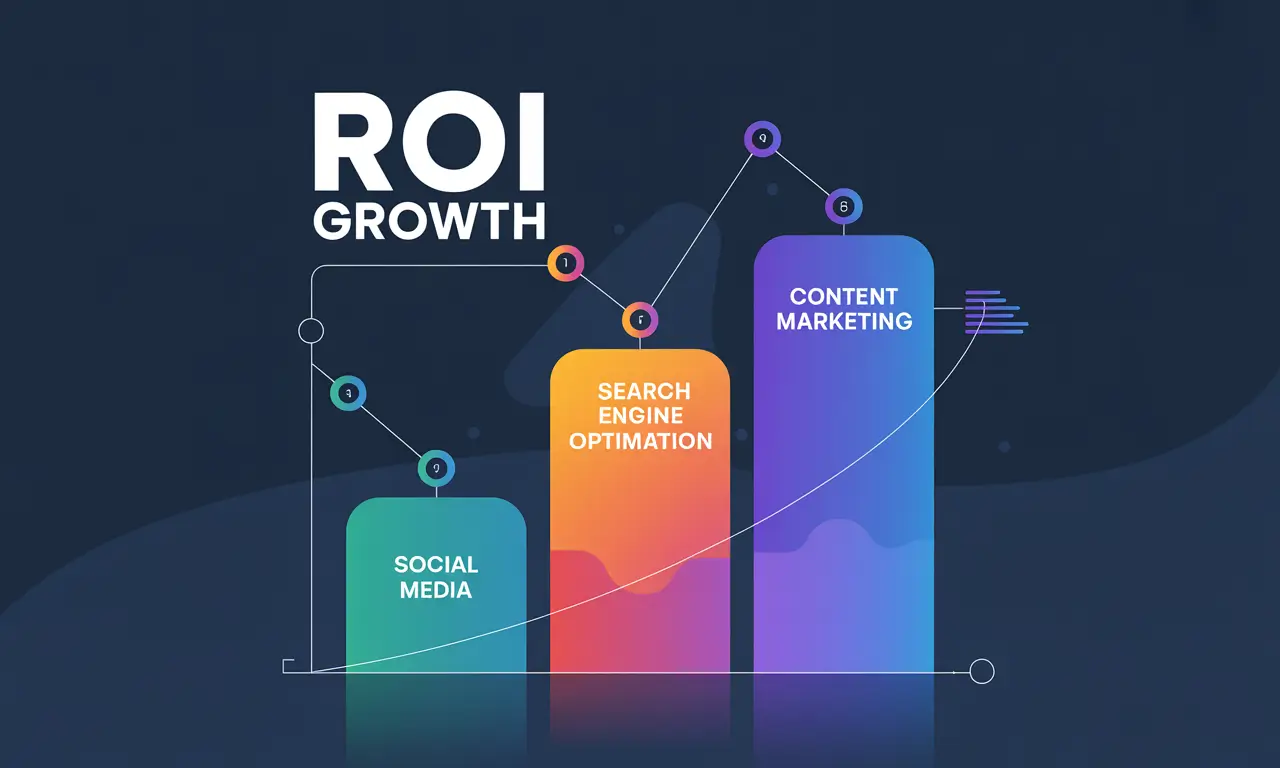What ROI means in marketing
Return on investment (ROI) shows how much profit you made for every pound spent. The simplest formula is:
ROI = (Revenue from marketing − Cost of marketing) ÷ Cost of marketing
For paid media, you will also see ROAS (return on ad spend):
ROAS = Revenue from ads ÷ Ad spend
ROI includes all costs, such as agency fees, software, landing page work, and your time. ROAS looks only at media spend. Use ROAS for quick channel checks, then use ROI when you make budget decisions.
Set outcomes before you spend
Agree clear targets and timeframes so you can judge value fairly.
- Outcome: 40 qualified enquiries per month by month three.
- Cost limits: cost per lead under £35 by month three.
- Revenue target: £6,000 monthly revenue from tracked leads by month four.
- Timeframe: a 90-day pilot with weekly checks and a monthly review.
Track the full path from click to revenue
Essential tracking setup
- Analytics: set up events for forms, calls, checkouts, and bookings.
- Call tracking: dynamic numbers on pages with high intent. Keep your main number fixed on your Google Business Profile.
- UTM tags: tag all ads, posts, and emails so sessions are attributed correctly.
- CRM sync: push lead source and campaign into your CRM. Update with deal value and status.
- Revenue capture: pass order values or closed-won deal values back to analytics where possible.
The metrics that matter
- Leads: number of qualified enquiries.
- Cost per lead (CPL): media plus fees divided by leads.
- Conversion rate: lead to sale.
- Customer acquisition cost (CAC): total marketing cost divided by new customers.
- Average order value (AOV) or average contract value (ACV).
- Lifetime value (LTV): average gross margin from a customer over the relationship.
- Payback period: months to recover CAC from gross margin.
Quick examples with real numbers
Lead generation service business
One month of activity:
- Spend: £1,200 on ads, £600 on management and tools. Total cost £1,800.
- Leads: 60. Customers: 10. ACV: £300 per job. Gross margin: 50 percent.
- Revenue: £3,000. Gross profit: £1,500.
ROI = (£1,500 − £1,800) ÷ £1,800 = −16.7 percent. On first-month revenue it looks poor. If 30 percent of customers return once in the next 6 months at the same margin, add £450 gross profit. New ROI becomes (£1,950 − £1,800) ÷ £1,800 = 8.3 percent. Small, but now positive. This shows why you should factor in repeat work where it is predictable.
Ecommerce example
- Spend: £2,000 ads, £500 fees. Total cost £2,500.
- Revenue from campaigns: £10,000. Gross margin: 40 percent. Gross profit: £4,000.
ROAS = £10,000 ÷ £2,000 = 5.0. ROI = (£4,000 − £2,500) ÷ £2,500 = 60 percent. This is healthy and suggests room to scale.
How long to judge results
Allow time for testing and data. A fair guide:
- Paid search and paid social: first signals in 2 weeks, firmer view by 6 to 8 weeks.
- SEO and content: early leading indicators in 4 to 6 weeks, clearer impact by 3 to 6 months.
- Email nurture: early signs in 2 to 4 weeks, improved revenue contribution by 2 to 3 months.
Make comparisons fair
Attribution choices
- Last click: simple, but it over-credits lower-funnel channels.
- Data-driven or position-based: fairer split across touchpoints if your tools support it.
Pick one model and stick with it for quarter-to-quarter comparisons. Changing models mid-test makes trends hard to read.
Improve ROI without raising spend
- Fix tracking gaps: missing events or wrong UTM tags can hide real winners.
- Tighten targeting: exclude poor locations, hours, and placements. Use exact match for proven terms.
- Lift conversion rate: strengthen headlines, proof, and forms on landing pages. Improve page speed on mobile.
- Raise AOV or LTV: add bundles, cross-sells, follow-up offers, or simple retention emails.
- Cut waste: pause keywords, creatives, or audiences that sit well above target CPL.
What is a good ROI?
Benchmarks vary by sector and margin. Many UK SMEs aim for at least 3:1 ROAS on paid media and positive ROI within 3 to 6 months when all costs are included. High-margin businesses may scale at lower ROAS. Low-margin businesses often need higher ROAS to stay profitable.
Build a simple ROI dashboard
- Spend by channel.
- Leads, CPL, and lead quality score.
- Sales, conversion rate, CAC.
- Revenue, gross margin, ROAS, ROI.
- Payback period and LTV:CAC ratio.
Targets: aim for LTV:CAC above 3:1 and payback under 6 months where possible. Adjust for your cash flow and margin profile.
Common mistakes
- Judging SEO on revenue after 4 weeks.
- Counting enquiries as wins without checking lead quality.
- Comparing channels with different intent on the same CPL target.
- Forgetting fees and build costs in ROI.
- Changing multiple variables at once, which hides cause and effect.
A 90-day plan to test if it is worth it
- Month 1: fix tracking, agree targets, launch two ad groups per theme, publish one strong landing page and one article.
- Month 2: scale winners, pause losers, test new creative, refine audiences, add one upsell or bundle.
- Month 3: improve speed and forms, add call scripts, review ROAS and ROI, decide the next quarter plan.
Summary and next step
ROI tells you if digital marketing is worth it. Set clear outcomes, track the full path to revenue, use ROAS for quick checks, and use ROI for real decisions. Improve results by lifting conversion rate, trimming waste, and raising value per customer.
Next step: build a one-page dashboard with spend, CPL, CAC, ROAS, ROI, and payback. Review it weekly for 90 days and adjust based on the trend, not single-day swings.


